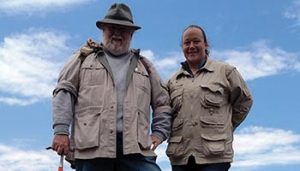By Joseph “PaleoJoe” Kchodl
CRYPTOLITHUS ulrichi has a very broad Cephalon bordered by a wide “brim,” which has a large number of pits or holes. It has been theorized that this trilobite was a filter feeder and that the wide brim and pits assisted in feeding.
The trilobite has six thoracic segments and a thin axial or central lobe. The pleural lobes are wide and unornamented. The Cephalon is roughly semi- circular and has two long genal spines. The Cephalon also has a large bulbous glabella.
Found near Nebo, Oklahoma, CRYPTOLITHUS ulrichi grew to around 1 inch with spines.
DID YOU KNOW: Trilobites, an extinct form of arthropod related to insects, crabs, crayfish, and horseshoe crabs, are among the most prevalent invertebrates with hard body parts to appear during the Cambrian Period. These creatures are called trilobite due to the three distinct “lobes” running vertically through the body section.

About the columnist: Joseph “PaleoJoe” Kchodl is a paleontologist, educator, veteran, author, fossil dig organizer/guide, business owner, husband, father, and grandfather, and fossil fanatic. For decades, he’s spent hours in classrooms around the Midwestern United States and beyond, speaking to school children about fossils and fossil hunting. Visit his site to purchase fossils, contact PaleoJoe, visit www.paleojoe.com.
Plus, learn more about PaleoJoe and his daughter PaleoJen and their paleontology exploration partnership in an the article “Fueling a Passion for Paleontology“.

